

Another exceptionally enjoyable trip! We got to camp via Jolon Rd from King City, through Fort Hunter-Liggett. I hadn't been through the fort since before "9/11", and so things were a bit different. Some of our car-pooling students arrived first at the entry gate. Each vehicle is asked for their drivers license, proof of insurance, and registration. There was some fumbling underneath seat cushions etc., but eventually we all made it through. We continued on up Nacimiento River canyon to Ponderosa Campground and grabbed 6 campsites near the top of the loop, just as we had for Astro 28A in 2000. I started right in on dinner - a jasmine rice / wild rice mix, cooked with fresh veges and coconut milk. The chemistry of the group was really excellent, with the Orr twins, Jessica's C. and H., and David especially adding life to our educational experience, and Heather adding plenty of volunteer help around the kitchen. As it got dark, we gathered 'round the telescope and binoculars and I lectured on the formation and evolution of stars, aiming my laser pointer to examples of different star types in the night sky. Sagittarius was well placed for studying the inner spiral arms and the rich details of the star forming regions here.
We had aweseome dark skies on Friday night and saw everything on my lists and
then 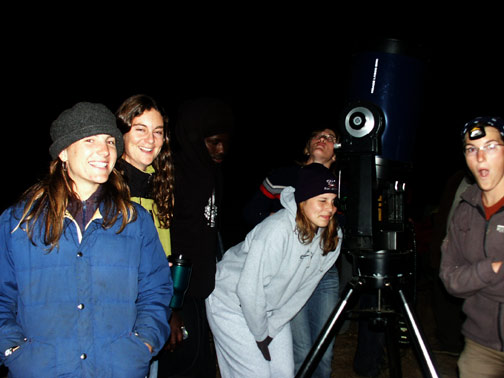 some;
from open clusters to globulars to the biggest galaxies in the sky, to lots
of famous and not so famous planetary nebulae, the showpiece emission nebulae
/ star formation regions of the Sagittarius spiral arm (the Eagle, Lagoon, Trifid,
and Omega nebulae), and the Veil Nebula supernova remnant in Cygnus. We even
got a chance to see a rare supernova bright enough to see optically with our
own eyes in a distant galaxy - the beautiful late-type spiral galaxy NGC 6846
in Cepheus had a 12th magnitude massive star Type II supernova near maximum
this weekend. This was the highlight for many (...there's something about young
people and big explosions). At right, the Orr twins are in a state of slack-jawed
awe, while Jessica enjoys the globular cluster M13 in Hercules.
some;
from open clusters to globulars to the biggest galaxies in the sky, to lots
of famous and not so famous planetary nebulae, the showpiece emission nebulae
/ star formation regions of the Sagittarius spiral arm (the Eagle, Lagoon, Trifid,
and Omega nebulae), and the Veil Nebula supernova remnant in Cygnus. We even
got a chance to see a rare supernova bright enough to see optically with our
own eyes in a distant galaxy - the beautiful late-type spiral galaxy NGC 6846
in Cepheus had a 12th magnitude massive star Type II supernova near maximum
this weekend. This was the highlight for many (...there's something about young
people and big explosions). At right, the Orr twins are in a state of slack-jawed
awe, while Jessica enjoys the globular cluster M13 in Hercules.
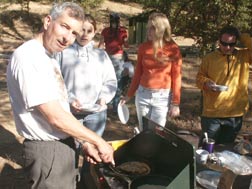 Next
morning was my promised French
Next
morning was my promised French  crepes
breakfast cooked over dual burners for maximum throughput! Saturday mornings
are usually the gourmet highlight of my field trip classes, as I cook crepes
and carve up plenty of fresh fruit and nut fillings. Jessica H and the Orr clones
happily carve away on bananas, pineapple, strawberries, peaches, and grapes.
Jessica C., Maria, and Chadwick wait with plates at the ready.
crepes
breakfast cooked over dual burners for maximum throughput! Saturday mornings
are usually the gourmet highlight of my field trip classes, as I cook crepes
and carve up plenty of fresh fruit and nut fillings. Jessica H and the Orr clones
happily carve away on bananas, pineapple, strawberries, peaches, and grapes.
Jessica C., Maria, and Chadwick wait with plates at the ready.
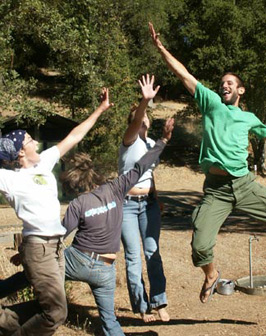
 Right,
powered by this fresh fruit and carbo meal and inspired by the beautiful Fall
colors at our camp site and the prospects of more astronomical wonders to be
unveiled, Jessica (gymnastics coach!) leads the Orr twins and Dave in an A-S-T-R-O
cheer. And capped with some high-5'ing all around.
Right,
powered by this fresh fruit and carbo meal and inspired by the beautiful Fall
colors at our camp site and the prospects of more astronomical wonders to be
unveiled, Jessica (gymnastics coach!) leads the Orr twins and Dave in an A-S-T-R-O
cheer. And capped with some high-5'ing all around.
Next we drove up the Naciemento canyon through a canopy of oaks and maples
in 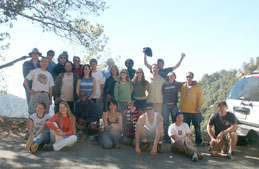 beautiful
yellow and orange colors to the saddle where Coast Ridge Rd crosses. Here, we
had a panoramic view of the Big Sur coast far below. I gave a lecture on inner
planet structural determiners - size and cooling rate and plate tectonics. Then
focused on the unique geologic history of California and Big Sur. I brought
along some metamorphic schist from camp and compared it to the road cut metamorphics,
all formed in the Mesazoic period 100 million years ago when a deep sea trench
defined California. Check out our happy crew below. Front row left to right
are Nicholas River, Chris, Mike, Otis, Jessica C., and smiling Dave. In the
back row is Kathryn, Aaron, Doug, Heather, Jessica H., Mark, Maria, Lindsay,
Darrell, Mila, Karen, Scott, Ingrid, Randa, and Chadwick. After the lecture,
students got some free time. Many went to the Jade Festival down near Sand Dollar
Beach, others did some studying for classes in nooks and crannies along the
rugged coast.
beautiful
yellow and orange colors to the saddle where Coast Ridge Rd crosses. Here, we
had a panoramic view of the Big Sur coast far below. I gave a lecture on inner
planet structural determiners - size and cooling rate and plate tectonics. Then
focused on the unique geologic history of California and Big Sur. I brought
along some metamorphic schist from camp and compared it to the road cut metamorphics,
all formed in the Mesazoic period 100 million years ago when a deep sea trench
defined California. Check out our happy crew below. Front row left to right
are Nicholas River, Chris, Mike, Otis, Jessica C., and smiling Dave. In the
back row is Kathryn, Aaron, Doug, Heather, Jessica H., Mark, Maria, Lindsay,
Darrell, Mila, Karen, Scott, Ingrid, Randa, and Chadwick. After the lecture,
students got some free time. Many went to the Jade Festival down near Sand Dollar
Beach, others did some studying for classes in nooks and crannies along the
rugged coast.
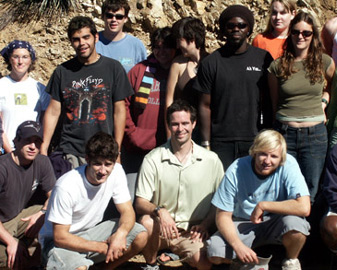

 Jessica
and I headed east, back down towards Hunter-Liggett to explore
Jessica
and I headed east, back down towards Hunter-Liggett to explore 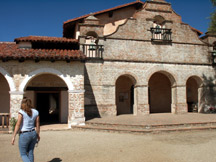 Mission
San Antonio, one of the best and least visited of the California missions. It's
about half a mile east of the main headquarters of Fort Hunter-Liggett, which
is based around William Randolf Hearst's hunting lodge.
Mission
San Antonio, one of the best and least visited of the California missions. It's
about half a mile east of the main headquarters of Fort Hunter-Liggett, which
is based around William Randolf Hearst's hunting lodge.
 The
mission grounds are kept with some of the original fruit trees and their offspring
planted by the missionaries, including pomegranate and figs.
The
mission grounds are kept with some of the original fruit trees and their offspring
planted by the missionaries, including pomegranate and figs.
Candle making was done by dipping a string into this tallow vat over and over.
 ...
is that a skull being carried by that priest? Those inquisition-era Catholics
were not to be trifled with by the natives!
...
is that a skull being carried by that priest? Those inquisition-era Catholics
were not to be trifled with by the natives!
Jessica remembers her childhood, in the large church. She helped explain the uses of the various balconies, side rooms, and
kneeling boards.
church. She helped explain the uses of the various balconies, side rooms, and
kneeling boards.
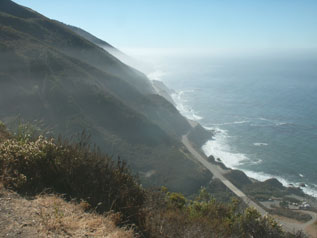
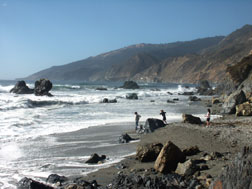 Later,
we headed to the beach. The rock types and minerals of the Big Sur are easiest
to decipher where they've been exposed at the coastline.
Later,
we headed to the beach. The rock types and minerals of the Big Sur are easiest
to decipher where they've been exposed at the coastline.
Here below Kirk Creek campground is chert and calcium carbonate-infused metamorphic
shale.
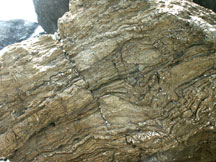 The
beaches contain bits of jade polished round by eons in the surf zone, here on
calcium carbonate veins. At left is metamorphic sedimentary rock showing severely
warped bedding in this folded, earthquake-faulted ancient subduction zone.
The
beaches contain bits of jade polished round by eons in the surf zone, here on
calcium carbonate veins. At left is metamorphic sedimentary rock showing severely
warped bedding in this folded, earthquake-faulted ancient subduction zone.
In late afternoon, we returned to camp and I fixed a dinner of pasta, basil/tomato
sauce, and fresh sliced veges with olive oil and parmesan. Heather brought home-made
brownies which we devoured while studying galaxies around the telescope, including
the one and only quasar-like example visible in small telescopes; the Seyfert
galaxy M77 in Cetus. Skies were so dark that we could see the Helix nebula without
an H-alpha filter. 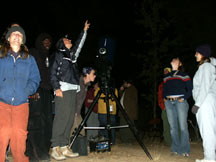 Then,
I recap'ed the value of timing the occultations of star by asteroids to determine
their precise sizes and shapes, and then the crew watched as I worked hard to
patch together the video system so we could watch for the occultation of a faint
star by the asteroid Jarmila. Alas, the predicted path was likely slightly south
of us, and we saw a near miss. (This is common; prediction errors and equipment
problems typically result in no-occultations for 3 out of every 4 attempts).
Then we packed the equipment into my car and got to sleep in order to get up
at 3:45am and drive the 50
Then,
I recap'ed the value of timing the occultations of star by asteroids to determine
their precise sizes and shapes, and then the crew watched as I worked hard to
patch together the video system so we could watch for the occultation of a faint
star by the asteroid Jarmila. Alas, the predicted path was likely slightly south
of us, and we saw a near miss. (This is common; prediction errors and equipment
problems typically result in no-occultations for 3 out of every 4 attempts).
Then we packed the equipment into my car and got to sleep in order to get up
at 3:45am and drive the 50  miles
to Lake Naciemento for the graze of 46 Leonis at 6am the next morning. I did
not make driving to the graze a requirement, since I would be
miles
to Lake Naciemento for the graze of 46 Leonis at 6am the next morning. I did
not make driving to the graze a requirement, since I would be  video-recording
the event for all to see and study during breakfast back at camp the next morning.
But still, three carloads of students volunteered to join me. We drove south
through Fort Hunter Liggett and had to show our papers again, this time without
trouble. Jessica was my co-pilot, monitoring the GPS unit to make sure we arrived
at the right longitude and latitude. I chose observing at 0.5 mi south of the
limit; risky because it was at the top of the lunar profile, but also promising
the most spectacular grazing events. While I set up, Chadwick managed to get
his car stuck in a ditch, but the rest of the crew bailed him out. At left,
SpongeBob sits before the TV and Jessica watches intently the highly magnified
thin northern cusp of the moon and the bright red giant star (click the picture:
the star is visible as a blob at the tip of the cusp on the TV monitor), while
Dave grins with... anticipation? We all waited and cheered for the star to disappear....
but it never did. Arghh! An apparent south shift resulted in a miss! And this
was the best graze of the year... Bummer!
video-recording
the event for all to see and study during breakfast back at camp the next morning.
But still, three carloads of students volunteered to join me. We drove south
through Fort Hunter Liggett and had to show our papers again, this time without
trouble. Jessica was my co-pilot, monitoring the GPS unit to make sure we arrived
at the right longitude and latitude. I chose observing at 0.5 mi south of the
limit; risky because it was at the top of the lunar profile, but also promising
the most spectacular grazing events. While I set up, Chadwick managed to get
his car stuck in a ditch, but the rest of the crew bailed him out. At left,
SpongeBob sits before the TV and Jessica watches intently the highly magnified
thin northern cusp of the moon and the bright red giant star (click the picture:
the star is visible as a blob at the tip of the cusp on the TV monitor), while
Dave grins with... anticipation? We all waited and cheered for the star to disappear....
but it never did. Arghh! An apparent south shift resulted in a miss! And this
was the best graze of the year... Bummer!
 We
looked at the Orion Nebula right after the graze,
We
looked at the Orion Nebula right after the graze, as
dawn began. A beautiful sunrise during the drive back to camp, and then I fixed
my Sunday breakfast - hash brown'd red rose pototoes in olive oil with anaheim
peppers, leeks, and plenty of cumin, cilantro, and other spices.
as
dawn began. A beautiful sunrise during the drive back to camp, and then I fixed
my Sunday breakfast - hash brown'd red rose pototoes in olive oil with anaheim
peppers, leeks, and plenty of cumin, cilantro, and other spices.
Darren and Chris warm in the first rays of sunlight.
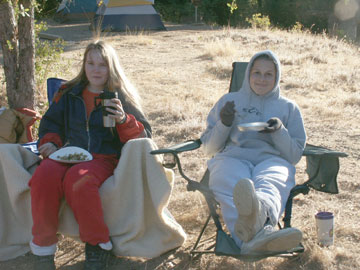 Jessica
and Maria have big smiles as they enjoy the hot breakfast in the October dawn
chill.
Jessica
and Maria have big smiles as they enjoy the hot breakfast in the October dawn
chill.
Then, it was time to say goodbye after a good weekend. On the drive home up
the coast,  I
stopped at Lime Kiln State Park; the sunlight filtering through the redwood
I
stopped at Lime Kiln State Park; the sunlight filtering through the redwood
 covered
streams make this one of the most beautiful spots on the Big Sur coast.
covered
streams make this one of the most beautiful spots on the Big Sur coast.
We'll return again in the future - Big Sur is one of the classic places for field astronomy. Join us!